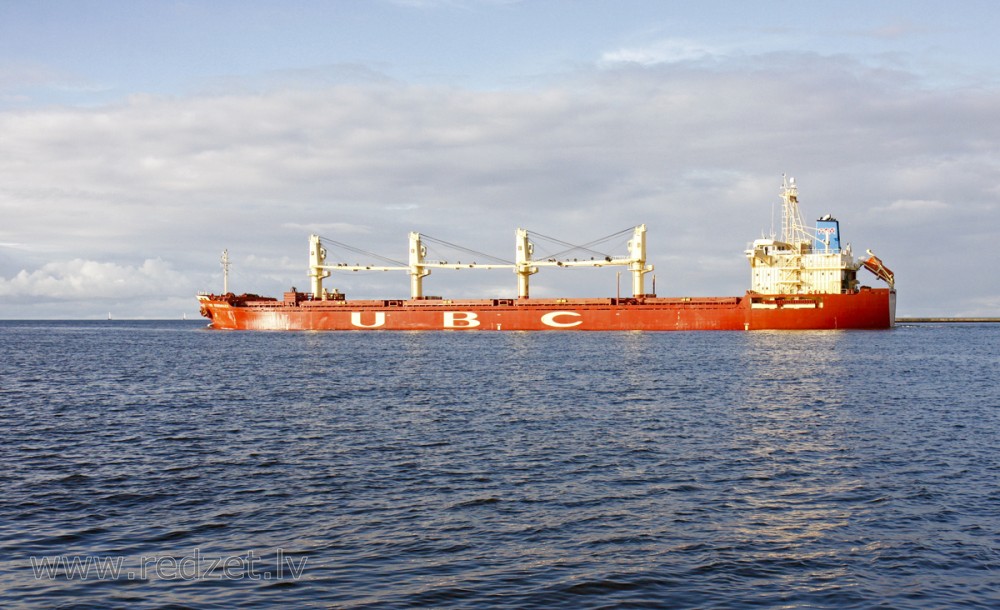Bulk Carrier
A bulk carrier, bulk freighter, or colloquially, bulker is a merchant ship specially designed to transport unpackaged bulk cargo, such as grains, coal, ore, and cement, in its cargo holds. Since the first specialized bulk carrier was built in 1852, economic forces have led to continued development of these ships, resulting in increased size and sophistication. Today's bulk carriers are specially designed to maximize capacity, safety, efficiency, and durability.
Today, bulk carriers make up 15–17% of the world's merchant fleets and range in size from single-hold mini-bulk carriers to mammoth ore ships able to carry 400,000 metric tons of deadweight (DWT). A number of specialized designs exist: some can unload their own cargo, some depend on port facilities for unloading, and some even package the cargo as it is loaded. Over half of all bulk carriers have Greek, Japanese, or Chinese owners and more than a quarter are registered in Panama. South Korea is the largest single builder of bulk carriers, and 82% of these ships were built in Asia.
On bulk carriers, crew are involved in operation management and maintenance of the vessel taking care of safety, navigation, maintenance and cargo care, in accordance with international maritime legislation. Cargo loading operations vary in complexity and loading and discharging of cargo can take several days. Bulk carriers can be gearless (dependent upon terminal equipment) or geared (having cranes integral to the vessel). Crews can range in size from three people on the smallest ships to over 30 on the largest.
Bulk cargo can be very dense, corrosive, or abrasive. This can present safety problems: cargo shifting, spontaneous combustion, and cargo saturation can threaten a ship. The use of ships that are old and have corrosion problems has been linked to a spate of bulk carrier sinkings in the 1990s, as have the bulk carrier's large hatchways. While important for efficient cargo handling, these allow the entry of large volumes of water in storms or if a ship is endangered by sinking. New international regulations have since been introduced to improve ship design and inspection, and to streamline the process of a crew's abandoning ship.
Definition
The term bulk carrier has been defined in varying ways. As of 1999, the International Convention for the Safety of Life at Sea defines a bulk carrier as "a ship constructed with a single deck, top side tanks and hopper side tanks in cargo spaces and intended to primarily carry dry cargo in bulk; an ore carrier; or a combination carrier." Most classification societies use a broader definition, by which a bulk carrier is any ship that carries dry unpackaged goods. Multipurpose cargo ships can carry bulk cargo, but can also carry other cargoes and are not specifically designed for bulk carriage. The term "dry bulk carrier" is used to distinguish bulk carriers from bulk liquid carriers such as oil, chemical, or liquefied petroleum gas carriers. Very small bulk carriers are almost indistinguishable from general cargo ships, and they are often classified based more on the ship's use than its design.
A number of abbreviations are used to describe bulk carriers. "OBO" describes a bulk carrier that carries a combination of ore, bulk, and oil, and "O/O" is used for combination oil and ore carriers. The terms "VLOC", "VLBC", "ULOC", and "ULBC" for very large and ultra-large ore and bulk carriers were adapted from the supertanker designations very large crude carrier and ultra-large crude carrier.
History
Before specialized bulk carriers were developed, shippers had two methods to move bulk goods by ship. In the first method, longshoremen loaded the cargo into sacks, stacked the sacks onto pallets, and put the pallets into the cargo hold with a crane.The second method required the shipper to charter an entire ship and spend time and money to build plywood bins into the holds. Then, to guide the cargo through the small hatches, wooden feeders and shifting boards had to be constructed. These methods were slow and labor-intensive. As with the container ship, the problem of efficient loading and unloading has driven the evolution of the bulk carrier.
Specialized bulk carriers began to appear as steam-powered ships became more popular. The first steam ship recognized as a bulk carrier was the British coal carrier SS John Bowes in 1852. She featured a metal hull, a steam engine, and a ballasting system which used seawater instead of sandbags. These features helped her succeed in the competitive British coal market. The first self-unloader was the lake freighter Hennepin in 1902 on the Great Lakes. This greatly decreased the unloading time of bulk carriers by using conveyor belt to move the cargo. The first bulk carriers with diesel propulsion began to appear in 1911.
Before World War II, the international shipping demand for bulk products was low—about 25 million tons for metal ores — and most of this trade was coastal. However, on the Great Lakes, bulk carriers hauled vast amounts of ore from the northern mines to the steel mills. In 1929, 73 million tons of iron ore was transported on the Lakes, and an almost equal amount of coal, limestone, and other products were also moved. Two defining characteristics of bulk carriers were already emerging: the double bottom, which was adopted in 1890, and the triangular structure of the ballast tanks, which was introduced in 1905. After World War II, an international bulk trade began to develop among industrialized nations, particularly between the European countries, the United States and Japan. Due to the economics of this trade, ocean bulk carriers became larger and more specialized. In this period, Great Lakes freighters increased in size, to maximize economies of scale, and self-unloaders became more common to cut turnaround time. The thousand-footers of the Great Lakes fleets, built in the 1970s, were among the longest ships afloat and in 1979, a record 214 million ton of bulk cargo were moved on the Great Lakes.
en.wikipedia.org
